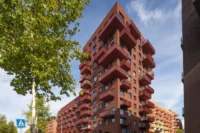When we think about architecture, stairs often take a backseat to grand facades and intricate details. Yet, they play a crucial role in our everyday experience of a space. A well-designed staircase not only enhances the aesthetic appeal of a building but also ensures safety and functionality. It’s the connective tissue that links different levels, guiding us seamlessly from one area to another.
In this stair design guide, we’ll explore the essential principles that shape effective stair design. From understanding the importance of dimensions and materials to considering user experience, we’ll cover everything architects need to create stunning and practical staircases. Whether you’re a seasoned professional or just starting out, our insights will help elevate your designs and inspire innovative solutions. Let’s dive in and discover how to transform stairs from mere functional elements into striking architectural features.

Importance Of Stair Design In Architecture
Stair design plays a crucial role in architecture, influencing both utility and beauty. Effective stair designs enhance movement within spaces while contributing to the overall aesthetic of buildings.

Functionality And Safety
Stair functionality hinges on usability and safety standards. Comfortable tread widths of 11 inches and riser heights of 7 inches optimize user experience. Adequate landings ensure smooth transitions, while clearly defined handrails provide support. Compliance with local building codes reduces potential hazards, such as slips and falls. We prioritize features like anti-slip surfaces and gentle slopes in public buildings to accommodate all users, including those with mobility challenges.
Aesthetic Appeal
Stair aesthetics significantly impact a building’s overall design. Unique materials, like glass or wood, can create stunning visual effects. Integrating stairs as a focal point with thoughtful lighting enhances their desirability. Curved or spiral staircase designs attract attention and foster interaction within spaces. We use color schemes and textures that harmonize with the surrounding environment, ensuring that stairs complement rather than clash with architectural elements.
Types Of Stair Designs
Stairs come in various designs, each serving specific functional and aesthetic purposes. We’ll explore some common types of stair designs, highlighting their distinct features and uses.

Straight Stairs
Straight stairs consist of a single, linear flight with no turns or landings. These stairs provide direct access between levels, making them efficient for both space and movement. They typically feature simpler construction, which can reduce costs. Common in residential settings, straight stairs work well in narrow areas and can be enhanced with railings and decorative elements for visual appeal.
Spiral Stairs
Spiral stairs feature a central pole with treads that radiate outward in a circular fashion, allowing for a compact design. These stairs maximize floor space, making them ideal for small areas or as functional art pieces. Spiral stairs can be constructed from various materials, including metal, wood, and glass, offering aesthetic versatility. We often see them used in open spaces such as lofts or as secondary access points.
L-Shaped Stairs
L-shaped stairs incorporate a landing that changes the direction of the flight by 90 degrees. This design enhances flow in spaces and provides opportunities for unique design elements. L-shaped stairs often create a corner feature in homes, allowing for interesting placements and supporting structures. The landing can serve as a resting point or display area, while the change in direction adds visual interest.
U-Shaped Stairs
U-shaped stairs consist of two parallel flights connected by a landing, forming a “U” shape. This design enables efficient elevation changes while incorporating a larger landing space, enhancing safety and accessibility. U-shaped stairs work well in larger homes and commercial spaces, often providing more opportunities for maneuvering and visibility. This design can also facilitate creative railings or materials to increase aesthetic value while ensuring compliance with safety standards.
Key Considerations In Stair Design
Effective stair design demands attention to several key factors. We focus on dimensions, materials, finishes, and accessibility to ensure both functionality and aesthetics in our projects.

Dimensions And Proportions
Dimensions and proportions directly affect stair usability and safety. Tread widths should typically measure between 10 and 11 inches, while riser heights should remain between 4 and 7 inches. Adequate clear headroom of at least 80 inches is vital to prevent accidents. Landings should span at least the width of the stairway, ensuring comfortable transitions between levels. Following the “Golden Ratio” can provide visually pleasing proportions, where the sum of the tread and riser heights reflects a harmonious relationship.
Materials And Finishes
Material selection significantly impacts both the aesthetic and functional qualities of stairs. We commonly use wood, concrete, metal, and glass—each offering distinctive visual and tactile contributions. For instance, hardwood provides warmth, while metal exudes modernity. Finish selections, such as textures and colors, enhance the design while ensuring durability and safety. Anti-slip finishes remain essential to prevent accidents. Thoughtful integration of lighting can accentuate material textures, enhancing visual appeal and guiding users.
Accessibility Standards
Accessibility standards play a crucial role in stair design. Compliance with the Americans with Disabilities Act (ADA) ensures inclusivity. Stairs should incorporate handrails positioned at 34 to 38 inches high for support, with extensions at both ends for user safety. Each step must provide uniformity in height and width, facilitating smooth movement. We also consider tactile indicators at landings to assist visually impaired individuals. Clear signage helps identify stairs, ensuring our designs promote safety and accessibility for all users.
Common Mistakes To Avoid
We recognize that common missteps in stair design can diminish both functionality and safety. Here are some critical areas to avoid pitfalls.

Poor Slope And Rise
We must ensure the slope and rise of stairs adhere to guidelines for comfort and safety. The riser should not exceed 7 inches, while the tread depth should be a minimum of 10 inches. A steep slope leads to discomfort and increased risk of accidents. We recommend a rise-to-run ratio of 1:1.5 or lower, which aids in a more gradual ascent and descent. Upkeep of this ratio enhances user experience and reduces the likelihood of falls.
Inadequate Landing Space
We focus on landing spaces, which serve as critical transitions between stair flights. Each landing should measure at least the width of the stairs and extend a minimum of 36 inches deep. Insufficient landing space can create hazards during movement, especially when carrying objects. Ensuring ample space not only supports safety but also enhances the overall flow of the environment. Adequate landing areas contribute to user experience and maintain visual coherence with the stair design.
Conclusion
Stairs are integral components of architectural design, blending functionality with visual appeal. Their design involves meticulous attention to dimensions, materials, and user experience, significantly impacting overall space usage and aesthetics. We recognize the importance of adhering to safety guidelines and design principles. Proper tread widths and riser heights enhance comfort and prevent hazards.
Our exploration of stair types, including straight, spiral, L-shaped, and U-shaped designs, showcases their unique functionalities and aesthetic potentials. Each type offers distinct advantages, allowing architects to tailor stair solutions to specific environments.
Material selection remains vital, with options ranging from wood to glass. Choosing the right materials affects both durability and visual impact, reinforcing the stair’s role as a feature within a building.
Accessibility considerations ensure compliance with standards like the Americans with Disabilities Act (ADA), fostering inclusivity. We prioritize designs that accommodate all users, promoting safe and comfortable navigation.
Avoiding common design mistakes, such as improper slope ratios and insufficient landing spaces, enhances safety and usability. Correct design choices assure stairways not only serve their purpose effectively but also elevate the overall architectural aesthetic.
- aesthetic stairs
- architectural stair trends
- architecture stairs
- commercial stair design
- contemporary staircase design
- custom staircases
- functional stair design
- innovative stair solutions
- interior design stairs
- modern stair design
- residential stair architecture
- space-saving stair ideas
- stair design guide
- stair design tips
- staircase aesthetics
- staircase architecture
- staircase enhancement
- staircase functionality
- staircase planning
- staircase styling
















Leave a comment